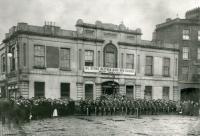countdown to 2016:Liberty Hall: ‘the centre of social anarchy in Ireland’ by Joseph E.A. Connell Jr
Published in 20th Century Social Perspectives, 20th-century / Contemporary History, Issue 3 (May/June 2012), Reviews, Revolutionary Period 1912-23, Volume 20
A contingent of the Irish Citizen Army parades (with Howth rifles) outside Liberty Hall in September 1914. (George Morrison)
Located at 18 Beresford Place at Eden Quay, the current headquarters of SIPTU stands on the site of the original Liberty Hall, which faced the Custom House, not the quays. In the early nineteenth century the building had been a chophouse. Later it was the site of the Northumberland Commercial and Family Hotel and the meeting place for members of the Young Ireland movement, and later still for members of the Land League. In 1912 it became the headquarters of James Larkin’s Irish Transport and General Workers’ Union (ITGWU). A decision to establish the union was taken at a meeting in Dublin in December 1908. The union’s first office was on Townsend Street, but soon it rented a room at 10 Beresford Place. In March 1912 the rented room was vacated and the Northumberland Hotel was taken over in its entirety. In 1911 the ITGWU had about 4,000 paid-up members, but this doubled to about 8,000 by the end of 1912, and to 10,000 by the middle of 1913. The Irish Citizen Army (ICA) was proposed in October 1913, giving equal rights to men and women. The Starry Plough banner made its first appearance at that time. In early 1914 Connolly announced the establishment of the ICA ‘to protect workers’ meetings’ and ‘to prevent the brutalities of armed thugs occurring in the future’. Though it had been formed to protect the workers, the ICA was never called into action in any major way during the Lockout. Liberty Hall was the headquarters of the ICA, of which Connolly eventually became O/C. On 13 November 1913, at a victory meeting to celebrate Larkin’s release from prison, Connolly announced outside Liberty Hall:
‘I am going to talk sedition. The next time we are out for a march I want to be accompanied by four battalions of trained men with their corporals and sergeants. Why should we not drill and train men as they are doing in Ulster?’
The newspaper Irish Worker was published at the hall and was suppressed in 1914. The Worker, also edited by James Connolly, was subsequently founded and suppressed after six issues. On 16 April 1916 the flag of the Irish Republic, with the harp but without the crown, was first raised over the hall; Molly O’Reilly, aged fifteen, unfurled it. Connolly handed the flag to her and said: ‘I hand you this flag as the sacred emblem of Ireland’s unconquered soul’. Mary Shannon, a machinist at the Liberty Hall shirt-making cooperative, made the flag. From 26 March to 16 April 1916 James Connolly’s play Under which flag had its first performances at Liberty Hall, with Seán Connolly in the lead role. It was about an Irishman torn between serving Ireland in the ICA or in the British army. On 23 April, in his final lecture on tactics at the hall, Connolly warned:
‘The odds against us are a thousand to one … In the event of victory, hold onto your rifles because the Volunteers may have a different goal, and may stop before our goal is reached. Remember, we’re out not only for political liberty, but for economic liberty as well. So hold onto your rifles.’
Because of the activities that issued forth from Liberty Hall, officials at Dublin Castle considered it the centre of nationalist sentiment. The newspapers described it as ‘the centre of social anarchy in Ireland, the brain of every riot and disturbance’. On Wednesday 26 April Liberty Hall was fired upon by HMS Helga—she fired 24 rounds. Liberty Hall was also bombarded by artillery from across the Liffey. Standing at 195ft, the present-day Liberty Hall is the tallest building in Dublin and rises sixteen storeys. Construction began in 1961 and finished in 1965. HI
Joseph E. Connell is the author of Dublin in rebellion: a directory, 1913–1923 (Lilliput Press, 2006).
Further reading:
C. O’Shannon (ed.), Fifty years of Liberty Hall, 1909–1959 (Dublin, 1959).


















